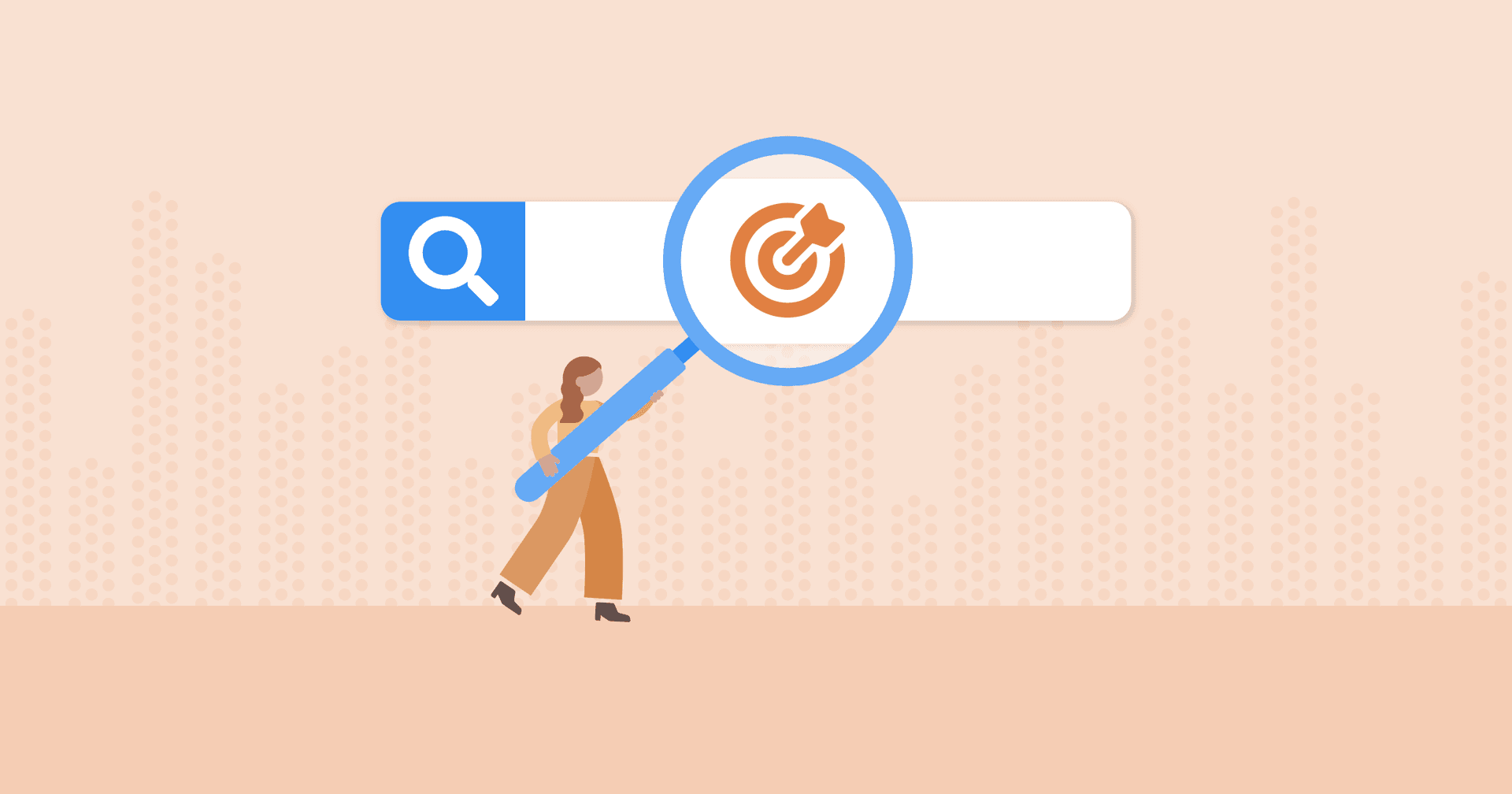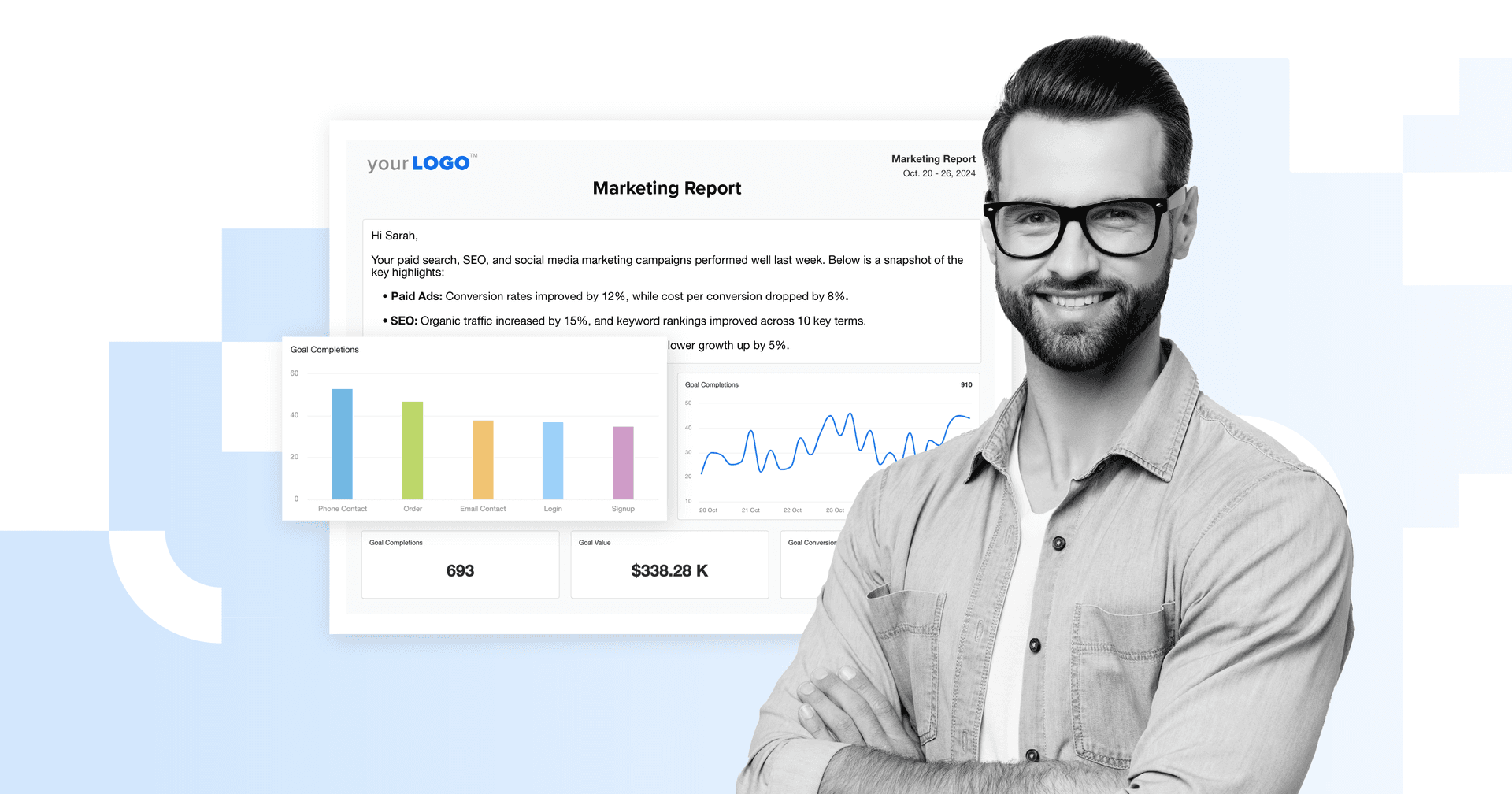Table of Contents
QUICK SUMMARY:
SEM tracking allows agencies to connect search performance to client outcomes, optimize campaigns, and maximize ROI. SEM is evolving fast, with AI Overviews, zero-click searches, and rising ad costs reshaping how businesses show up in search. In this article, you’ll learn how to measure SEM success in 2025.
In the past, winning a top spot on the SERP almost guaranteed clicks and traffic. Today, that dynamic has shifted. AI Overviews and zero-click searches are changing how users interact with search, meaning visibility alone no longer guarantees engagement.
Paid and organic strategies now inform each other more than ever: PPC can reveal high-converting keywords for search engine optimization (SEO), and strong organic rankings can improve ad quality scores and lower costs.
Tracking search engine marketing (SEM) performance is a must for agencies that want to demonstrate real business outcomes, show ROI, and position themselves as strategic partners rather than just service providers.
What is SEM tracking?
SEM tracking is the process of monitoring and analyzing the performance of your clients’ search engine marketing efforts, encompassing both paid campaigns (PPC) and organic strategies (SEO). Rather than focusing on clicks or impressions, it measures which actions on the SERP actually generate meaningful business outcomes, such as calls, appointments, or sales.
In 2025, we’ve seen the search landscape change dramatically. Many agencies are shifting resources from SEO to PPC. Our 2025 Marketing Agency Benchmarks Report revealed that the majority of agencies believe PPC is the most promising marketing channel in 2025–a new development since last year when SEO had the top spot.
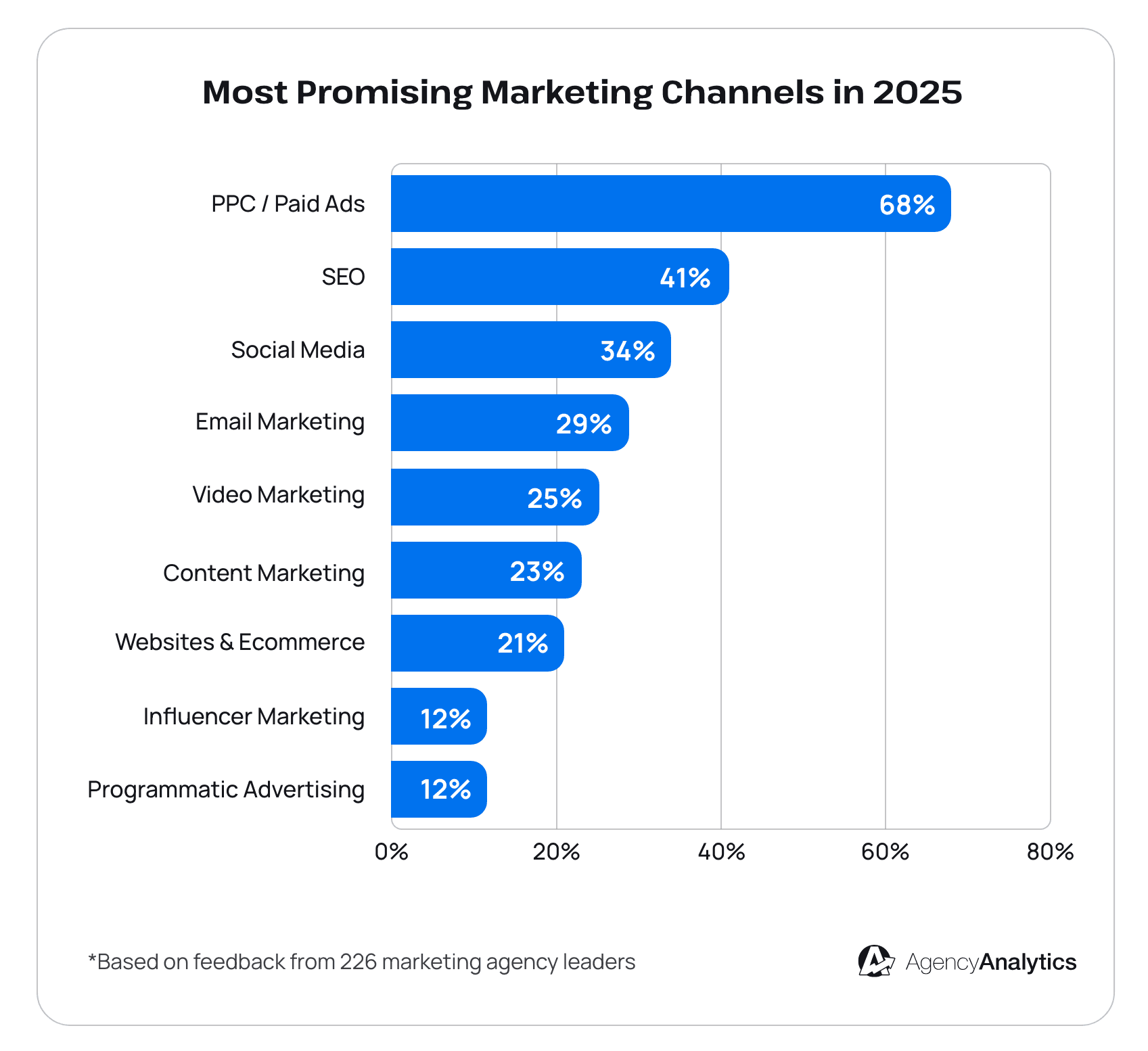
89% of agencies say that paid ads are also the top service offered by marketing agencies today. With SEO and PPC working hand-in-hand, monitoring SEM performance is the best way to keep clients coming out on top this year.
Curious to learn how other agencies are maintaining SEM success in 2025? Download the full 2025 Marketing Agency Benchmarks Report to learn more.
Modern SEM tracking for agencies
For agencies, SEM tracking serves a few strategic purposes:
Highlights which campaigns deliver true ROI
Dictates where to invest budget
Reveals opportunities to optimize both paid and organic channels
With the rise of AI-driven search features and zero-click results, the visibility-to-engagement connection is more complicated. Agencies that master SEM tracking can map each touchpoint back to actual business outcomes.
SEM tracking covers both SEO and paid search campaigns, letting agencies see how each channel contributes to business outcomes and where budget should be focused.
Why SEM tracking matters more than ever
Search engines have evolved rapidly, so your SEM strategy better keep up. AI-driven features like AI Overview panels and zero-click search results now answer many queries directly on the SERP without users clicking through to a website. What used to be a guaranteed path from visibility to traffic no longer exists.
For agencies, this shift makes SEM tracking invaluable: visibility alone no longer signals success–you need to measure real business outcomes.
Agency tip: Our ultimate guide to SEO tracking breaks down attribution models, cross-channel measurement, and privacy-compliant tracking setups that work specifically for local service providers.
As search continues to evolve, agencies must go beyond basic clicks and impressions to leverage deeper paid search analytics for a clearer understanding of SEM performance. Privacy changes, the shift to cookieless tracking, and the rise of AI-driven assistants like Bing Copilot and Google Gemini are creating “invisible” touchpoints that traditional metrics can’t capture.
To measure true impact, agencies should focus on:
Navigating privacy and cookieless tracking to maintain visibility and actionable data.
Measuring invisible influence, using branded keyword lifts, entity presence, and voice search referrals as proxies when clicks aren’t available.
Adapting attribution and reporting models to map SEM’s contribution across the entire customer journey, highlighting value beyond direct conversions.
Keyword research will tell you what your prospects care about, and competitor analysis will give you information on how to stand out.
Warren Thompson, Co-Founder and Managing Director, Ollo Metrics
All of this has driven demand for specialized SEM reporting software for agencies that goes beyond traditional metrics. To identify the right SEM reporting tool for your business, look for ones that integrate multiple data sources, like Google My Business data, call tracking, and AI referral insights–capabilities that generic analytics tools simply weren't designed to handle when managing dozens of local service providers simultaneously.
Show ROI clearly and confidently with AgencyAnalytics’ customizable SEM dashboards. Start your free 14-day trial today.
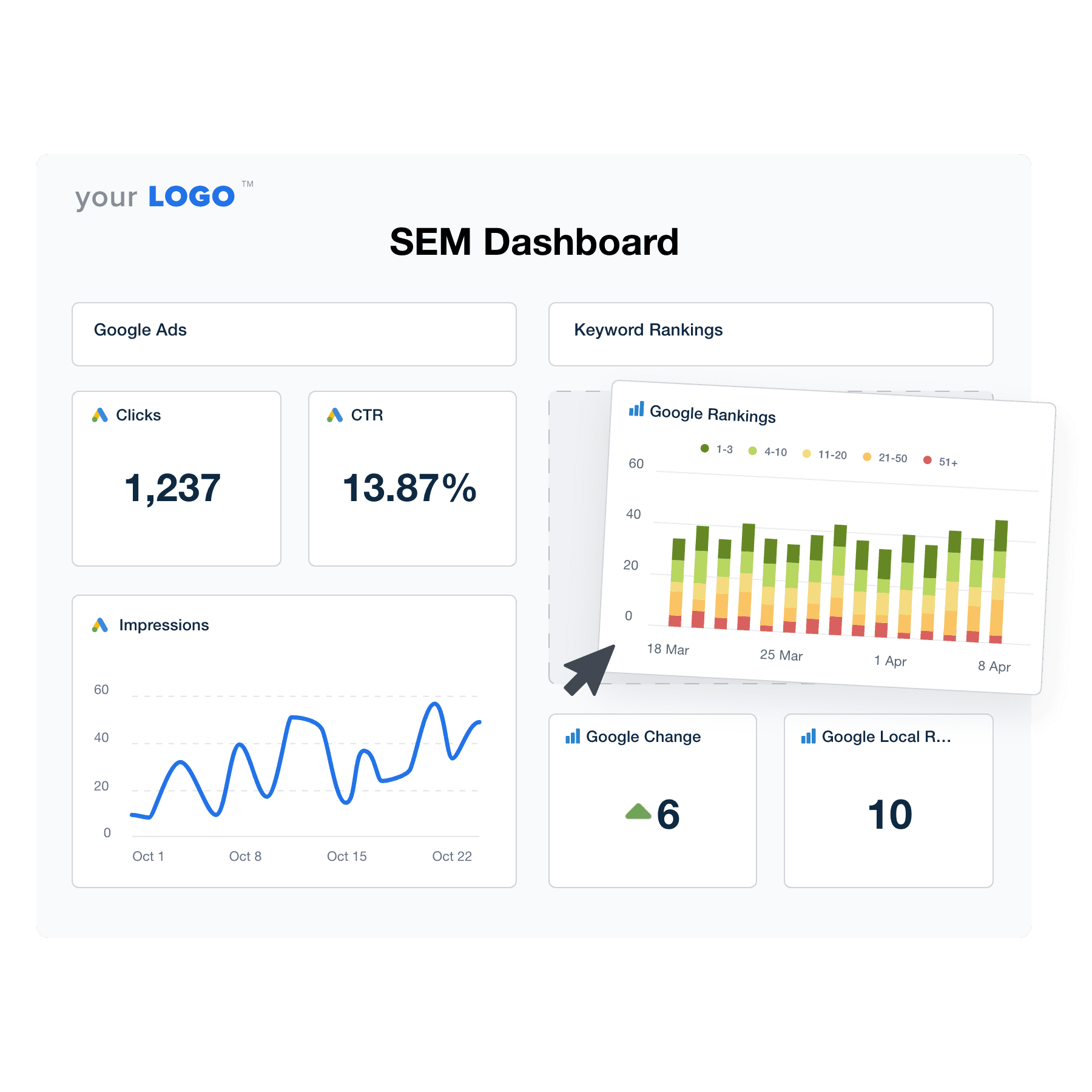
The attribution mistake most agencies are making
Most agencies use last-click attribution, giving 100% credit to whatever touchpoint immediately preceded the conversion. So if someone:
Sees your client’s ad (doesn't click)
Googles your client’s practice’s name a week later
Calls from the organic result
Traditional attribution gives the organic search 100% credit and the original ad zero credit.
Unfortunately, this method doesn’t necessarily surface accurate tracking. Consider that for local service providers:
Long consideration cycles: People research dentists, mechanics, contractors extensively before choosing.
Brand searches are the goal: The whole point of local SEM is getting people to remember the name of your client's business.
Offline conversions dominate: Most convert via phone calls days/weeks later.
For example: A plumbing company runs ads for "water heater repair." A potential customer sees the ad, doesn't click, but remembers the company name "Johnson Plumbing." Three days later when their water heater breaks completely, they search "Johnson Plumbing" and call directly.
Last-click attribution says: Organic branded search = 100% credit, Ad = 0% credit
Reality: The ad created the entire opportunity.
Most agencies don't track or give proper weight to:
View-through conversions (saw ad, didn't click, converted later)
Brand search lift (increase in branded searches after ad exposure)
Assisted conversions (touchpoints that influenced but didn't directly convert)
This makes SEM campaigns for local businesses look far less effective than they actually are, leading to budget cuts on campaigns that are actually driving most of the business.
The fix: Use attribution models that give partial credit to earlier touchpoints, especially for local businesses where brand awareness is the primary goal.
Agency Tip: Boost local Quality Scores by creating "radius-specific landing pages" that match your geographic targeting exactly. Instead of sending "plumber near me" traffic to a generic services page, create dedicated pages for "Emergency Plumber in [Neighborhood]" with local landmarks, area codes in headers, and neighborhood-specific testimonials.
How SEM tracking works
Think of SEM tracking as a strategic tool, not just a technical task. Not only does a strong setup report numbers, it helps uncover insights that shape strategy, drive better decisions, and help keep clients happy.
The key is combining first-party data, behavioral insights, and LLM referral tracking to see how campaigns actually drive user behavior across channels (including AI assistants like Bing Copilot or Google Gemini).
Finally, go beyond the numbers. Share original research and case studies that connect SEM data to real client ROI. This positions your agency as a thought leader and proves the value of your work.
Agency Tip: Use "conversion velocity mapping" to connect online activity to offline results. Track the time gap between keyword searches and phone calls by day of week and service type. Say that emergency services (locksmith, towing) convert within 2 hours, while dental appointments show a 3-5 day delay with Tuesday-Thursday peaks. Layer this timing data over your PPC spend to identify which keywords truly drive calls, not just clicks.
SEM tracking in action
To get a true picture of performance, agencies should track SEM results across multiple channels–from Google Ads and Bing to social search integrations–so they can connect every touchpoint in the customer journey.
These examples illustrate how thoughtful SEM tracking turns raw data into actionable insights, guiding strategy, optimizing campaigns, and proving client ROI, even in a search landscape dominated by AI and zero-click interactions.
How SEM tracking works for dentists
Imagine you’re running ads for a dentist with the goal of increasing patient bookings. Clicks and impressions from local PPC ads come into play, but you might also track how often the dentist’s name pops up in local search results. Compare this number with the number of new patient inquiries to show your client that the ads are directly impacting their bookings and bringing in revenue.
How SEM tracking works for auto repair shops
Say your client is an auto shop that wants to book more brake repairs. You can track calls and online appointments coming from PPC campaigns. To dig a bit deeper, check the service pages that people read after seeing the ad. Are they clicking “brake repair,” “oil change,” or something else entirely? This tells you if the ads are sending the right kind of traffic and whether they’re influencing customers, even if they don’t book right away.
How SEM tracking works for plumbers
Oftentimes when people are looking for a plumber, it’s an urgent matter. They’re Googling “plumber near me” or using voice search to find what they need ASAP. PPC ads make sure your client’s business shows up right at the top of search results, catching customers before they scroll to a competitor. From there, you can track what happens next–calls, direction clicks, or quote requests–to prove those ads are driving the urgent jobs that keep your client busy.
Stop guessing, start impressing. Turn your SEM data into client-winning dashboards–no spreadsheets required. Try AgencyAnalytics free for 14-days.
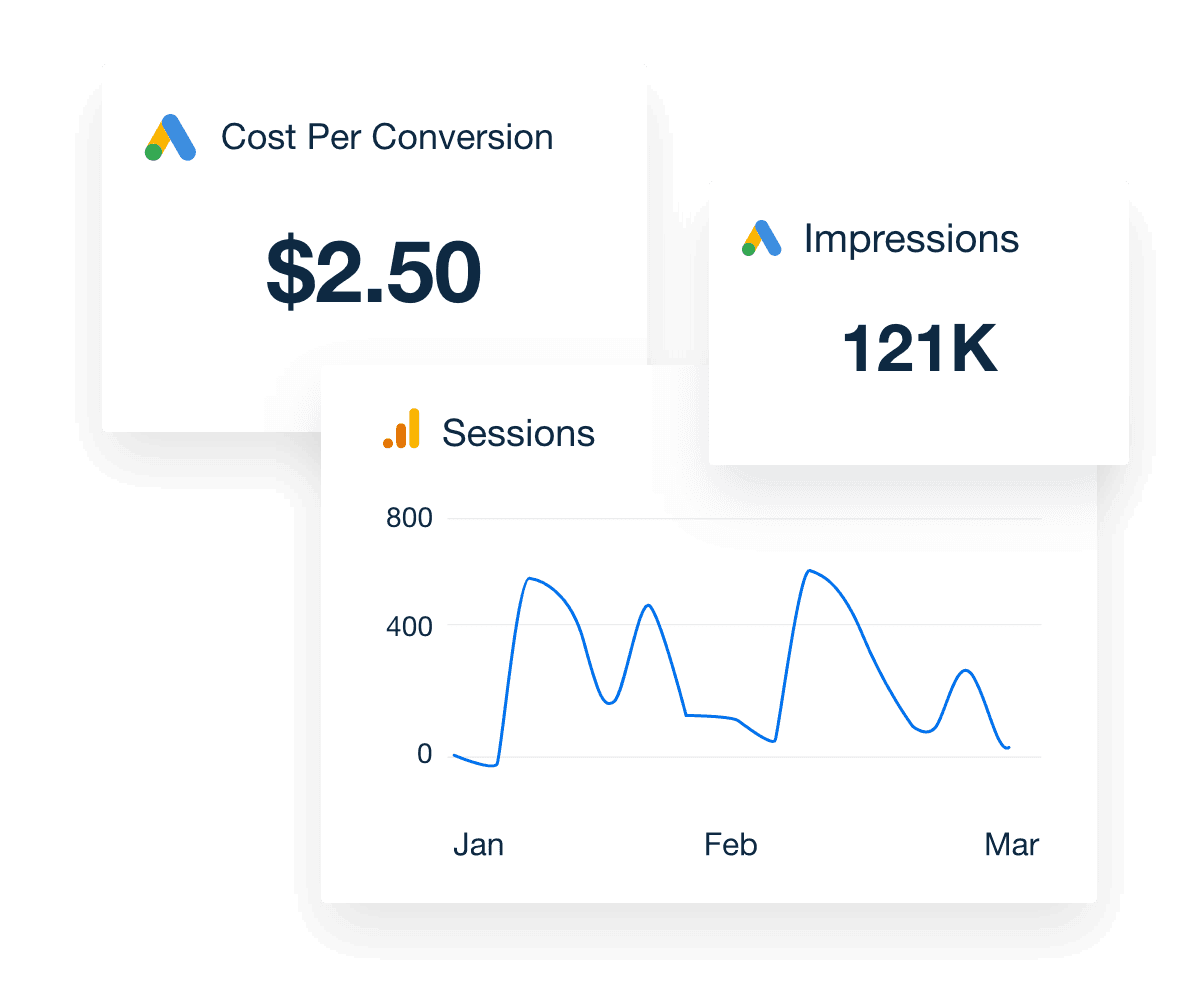
Why you need to track SEM results
Tracking and reporting on your clients’ SEM results is key to conveying the performance of your digital marketing campaigns.
Think of KPIs like a trail of breadcrumbs. You already know where your client is starting from, and you know where they want to end up. The key is figuring out the steps in between. By working backward from that destination, you can map the path and choose the right KPIs to track.
SEM is often the spark that sets the trail of breadcrumbs in motion. Ads get someone to click—but the click isn’t the destination. If your client’s goal (X) is, say, 30 new dental patients a month, tracking only impressions or clicks doesn’t tell the full story.
You need to see:
Which ads actually drove calls or form submissions?
Which keywords converted into booked appointments, not just website visits?
How much did each conversion cost compared to its value?
That’s where this formula comes in:
Goal (X) → Milestones/activities (Y) → KPIs (Z)
For SEM, the milestones are things like calls, bookings, or quote requests. The KPIs are conversion rate, cost per conversion, and keyword/ad performance.
If you only measure clicks, you’re leaving revenue on the table. Proper SEM tracking lets you follow the full trail from impression to impact, so you can show the real business outcomes your campaigns deliver and stop underselling your results.
With AgencyAnalytics, you're well on your way to automated reporting. Ready to make the switch? Try the SEM Report template free for 14 days.
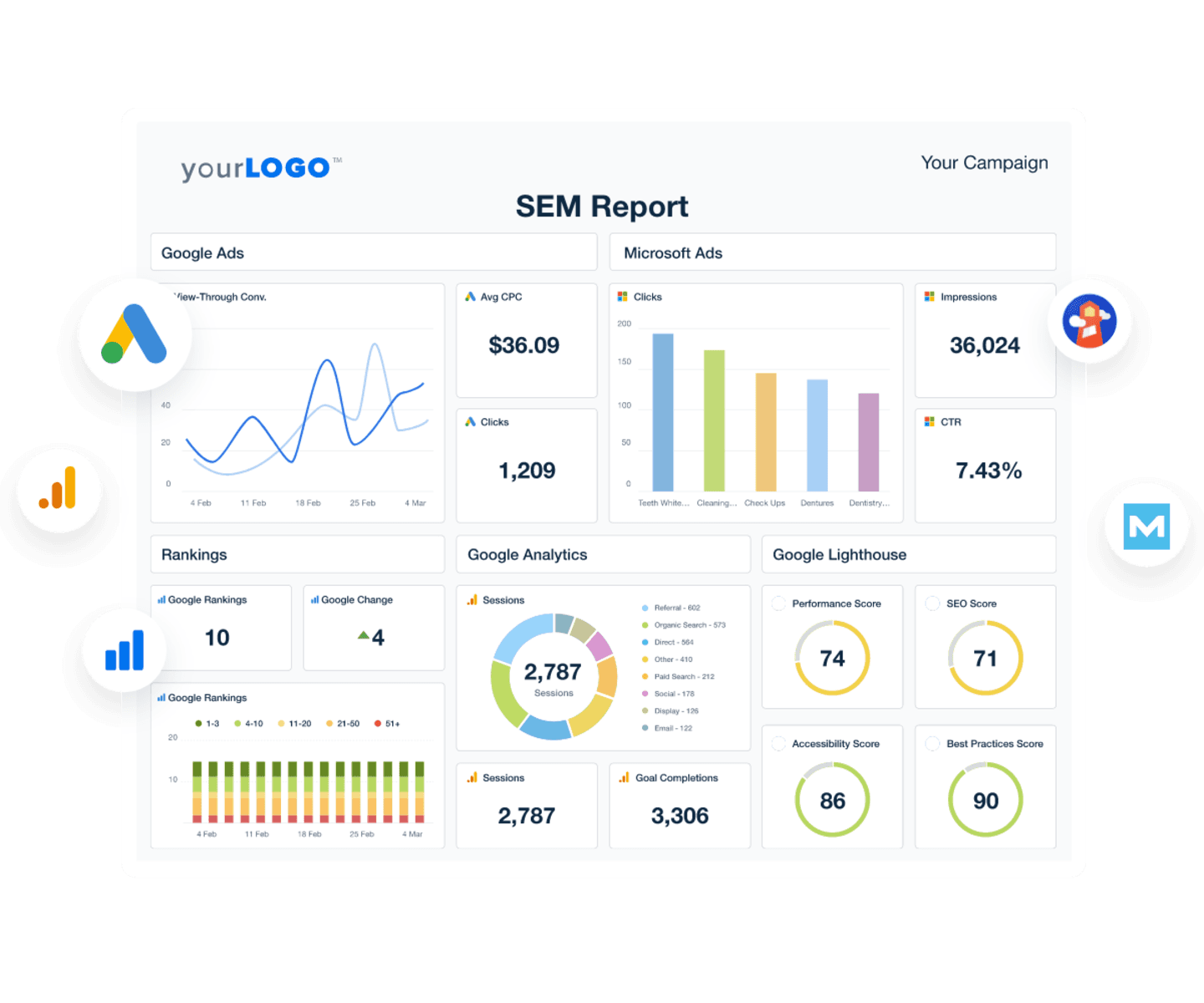
Key SEM performance metrics to track
If you’re just tracking clicks, you’re missing the big picture. Consider how often your ads are showing up (impression share), brand visibility across search results, and whether people are engaging with your client’s content. Keeping an eye on these metrics will help you gauge the broader impact of your client’s marketing efforts, signaling you’re moving in the right direction, even if traffic dips.
PPC’s first objective is to acquire qualified traffic, but as an agency that provides both PPC and SEO services, we also use PPC ads for testing and research. Before earning organic ranks for a keyword, we use PPC to test how users interact with a brand and its products.
Matt Beech, Marketing Director, patch.marketing
The metrics that matter most vary significantly by industry and client type. Our research with agency leaders–detailed in our guide to the best SEO analytics tools according to agency experts–reveals that successful agencies customize their KPI focus based on client vertical, with emergency services requiring completely different benchmarks than appointment-based businesses.
This approach ensures SEM tracking reflects real business impact and positions agencies as strategic partners in a rapidly changing search ecosystem.
Here are the top SEM metrics you need to track.
Click-Through Rate (CTR): Shows how many users click your client’s ads. High visibility without clicks signals a mismatch–maybe ad copy, targeting, or timing needs adjustment.
Quality Score (Google Ads): Evaluates ad relevance, landing page experience, and expected CTR. Higher scores lower costs and improve placement. Align ad copy with landing pages and target keywords actively searched by the local audience.
Agency Tip: Here's what most agencies miss: For local service providers, a slightly lower Quality Score can actually be profitable if it means showing for high-intent emergency searches. A locksmith's 4/10 Quality Score on 'locked out of car' keywords often converts better than their 8/10 score on 'locksmith near me’.
Conversion Rate (CR): Measures the percentage of users who complete a desired action. High CTRs are meaningless if traffic doesn’t convert.
Cost per Acquisition (CPA): Links spend to results. High CPA might point to broad targeting, inflated bids, or weak offers. Optimizing CPA ensures budget efficiency while driving real business outcomes.
Cost per Click (CPC): Indicates how much each click costs. A high CPC isn’t bad if conversions justify it; conversely, a low CPC can be wasteful if traffic doesn’t convert. Monitor CPC alongside CR and CPA for actionable insights.
Impression Share: Tracks how often ads appear compared to total opportunities. Low impression share may reveal budget caps, bid issues, or technical problems.
Return on Ad Spend (ROAS): Measures revenue per dollar spent. Even strong CTRs and low CPAs are insufficient if revenue impact is weak.
Agency Tip: Compare CTR and CPC to industry benchmarks. If CTR lags, use ad extensions like callouts, site links, and structured snippets to improve visibility and clicks. With AgencyAnalytics, you have access to proprietary industry benchmarks from agencies just like yours. Compare, compete, and keep clients climbing in the SERPs. Try it free for 14 days!
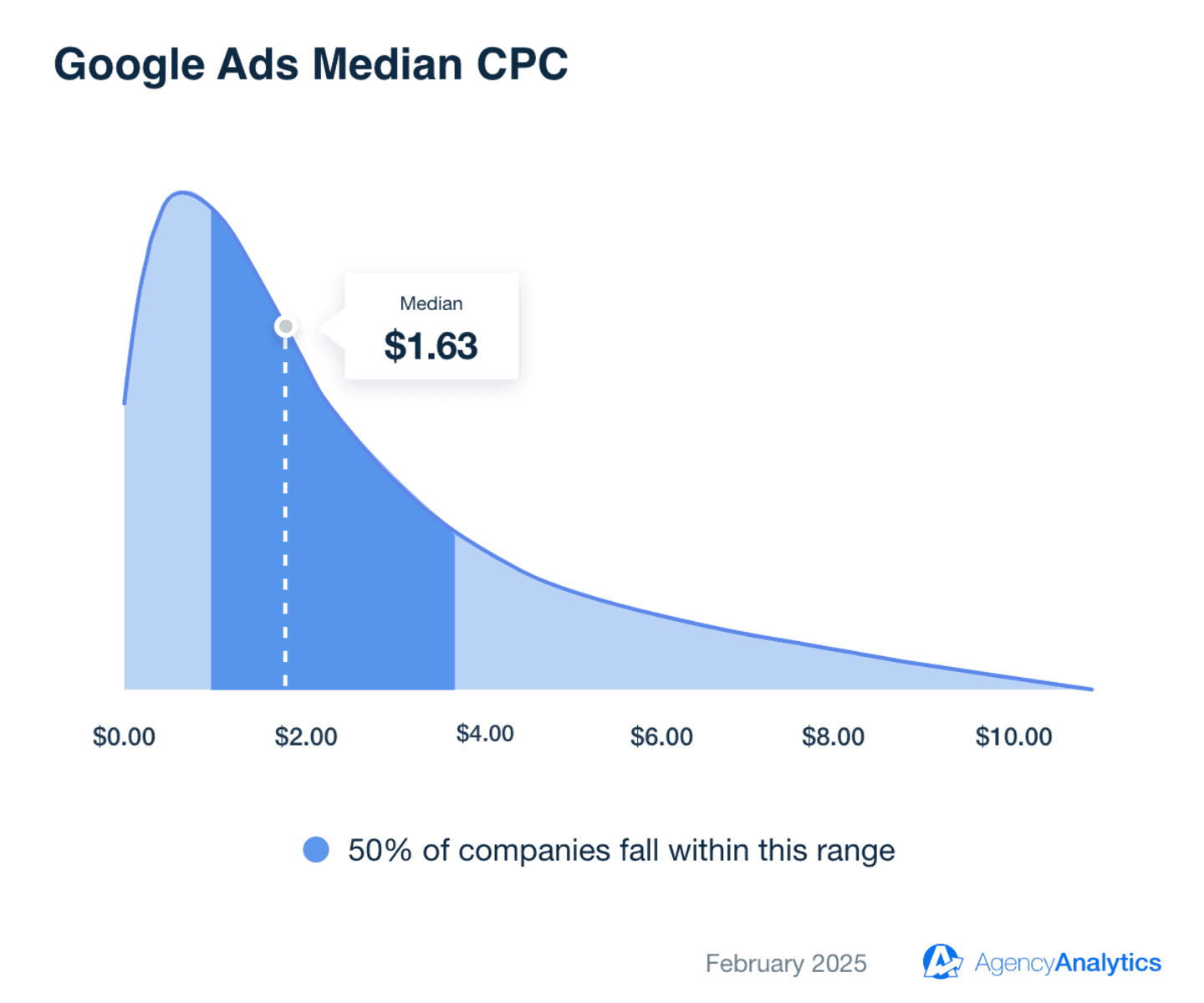
How to build accurate and effective SEM tracking reports
Tracking results is one thing–reporting them is where the real magic happens. A great report doesn’t just dump data on your client’s lap; it tells a story. It shows what’s working, what’s not, and what to do next.
The key is translating all those clicks, CPCs, and conversion rates into plain English (or plain numbers) that actually mean something to your client’s business.
Instead of just saying “CTR is up,” connect the dots: “The ad copy tweak brought in 20 more calls this week.” That’s the kind of insight that turns you from a service provider into a strategic partner.
Here are some essential features of effective SEM tracking reports:
Segment and dissect performance
Segmentation reveals hidden opportunities. Break out results by campaign, device, geography, and audience to uncover pressure points and high-performing pockets. With tools like AgencyAnalytics, these layers are easy to visualize, letting you spot trends that raw totals would obscure.
Look for platforms that support unlimited data exports, automated scheduling, and API access, so in-house teams can integrate everything seamlessly, from organic search and backlink data to paid ads and keyword tracking. Bonus features like unlimited domain overview PDFs and priority support ensure you can scale without limits.
This level of integration transforms how you deliver value. Instead of spending hours manually compiling reports, you’re providing automated insights that feed directly into client decision-making. Advanced platforms even let you tie conversions to domain contacts, linking form fills, calls, and chat interactions to actual customer profiles and giving agencies a holistic view of campaign impact.
Dynamic data visualization
When presenting your digital strategy results, different stakeholders will have different levels of "data fluency." C-suite executives want clean dashboards showing ROI, ROAS, and revenue generated from search advertising across Google Analytics and Microsoft Ads. Meanwhile, marketing teams need granular details–CTR by ad groups, how much advertisers bid on keywords from your PPC keyword research, and campaign tracking across multiple platforms including Bing Ads.
The challenge is presenting the data in a way each audience can actually use. Your client's sales team doesn't need to understand the nuances of organic search results or backlink analysis–they want to know which campaigns drove the most qualified leads. But their marketing teams need that granular keyword tracking and campaign tracking data to optimize performance across multiple platforms.
The best platforms eliminate manual effort by automatically translating the same data for each audience. Instead of pulling historical data from Google Search Console for technical teams, then switching to your competitive intelligence tool for executive summaries, then manually creating custom reports, you need solutions that adapt presentations to match each viewer's data literacy level.
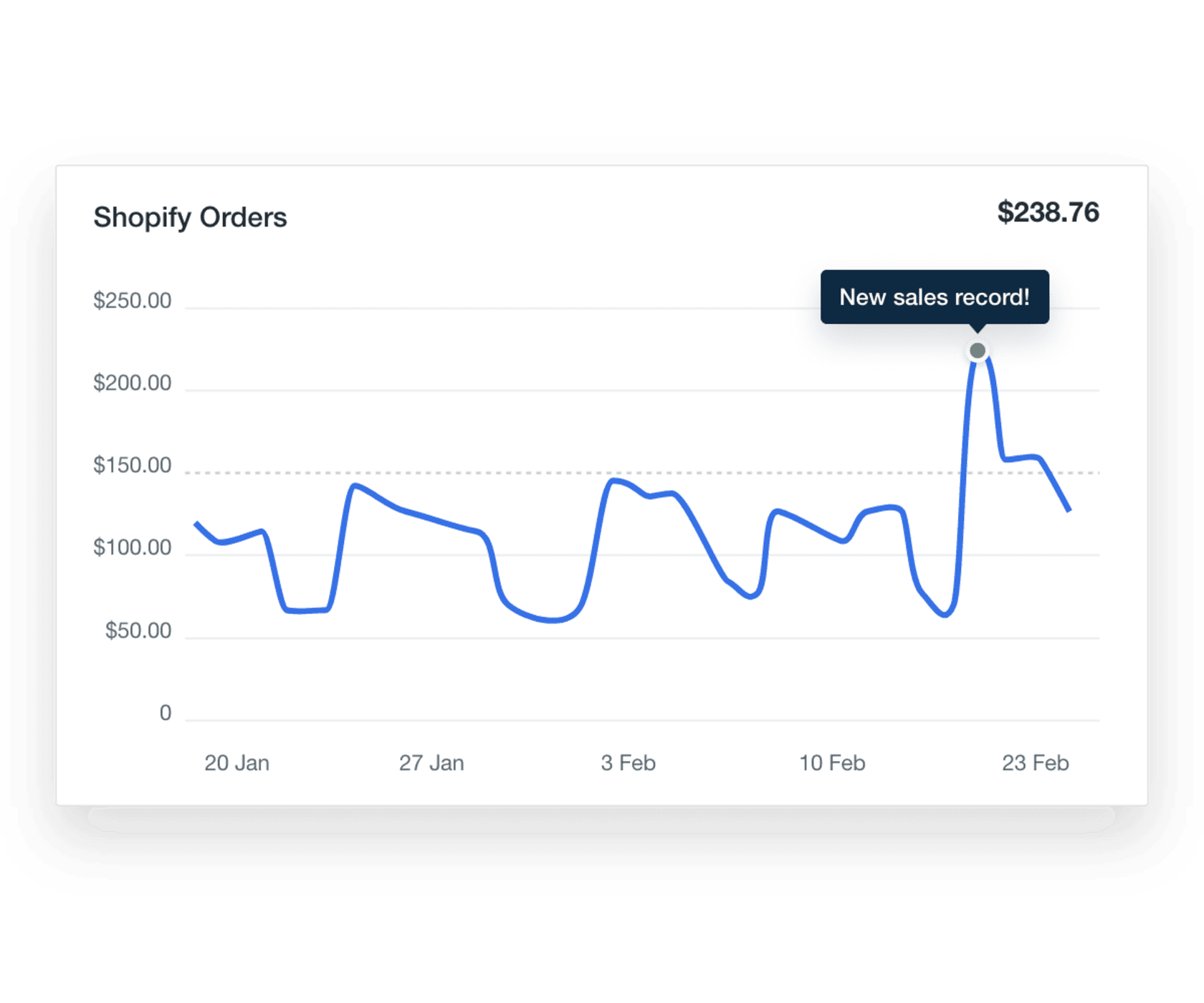
AgencyAnalytics empowers your agency to tell the full story of your marketing efforts. Combine data across multiple channels–PPC, SEO, ecommerce, social media–and from more than 80 platforms. Sign up for your free 14-day trial today!
Integrate AI-powered analytics
Predictive modeling and AI insights take SEM reporting to the next level, from descriptive to prescriptive. Agencies forecast performance, optimize budget allocation across channels, and improve attribution accuracy, ensuring campaigns are both efficient and effective.
Agency Tip: When you’re managing this level of complexity across multiple local clients, your tools better be up to the task. After testing the 12 best SEM reporting tools to boost search marketing performance, we found the standout platforms share two key features: automated local reporting and AI-powered insights that surface opportunities you'd otherwise miss.
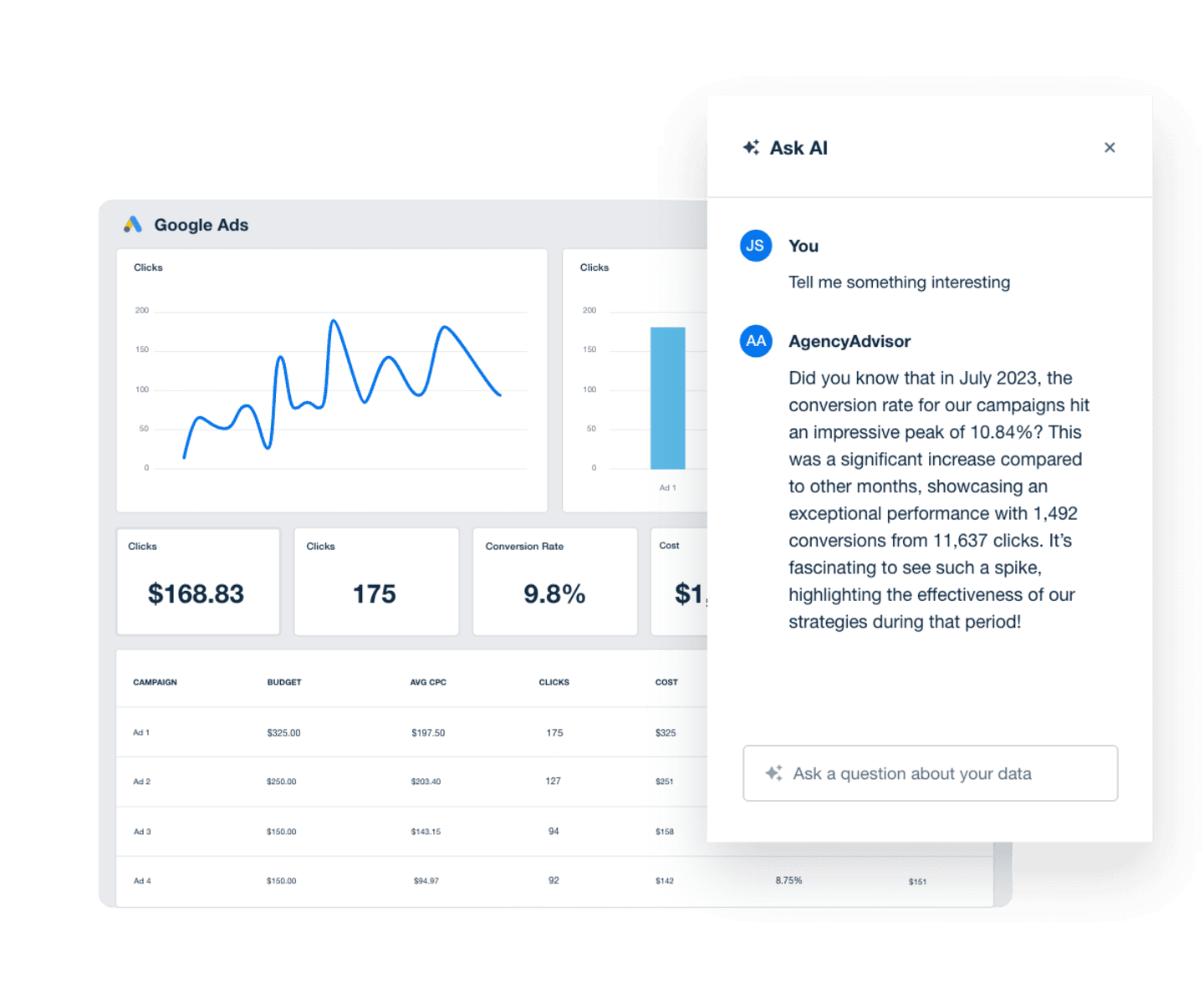
Schedule regular deep-dive sessions
Make time for routine reviews where strategists analyze not just what happened, but why it happened–and what to do next. AgencyAnalytics dashboards power these discussions, providing a centralized, data-rich environment to make informed decisions and plan next steps confidently.
With advanced segmentation, visual dashboards, AI insights, and structured interpretation sessions, SEM tracking reports become a strategic tool for driving client growth, optimizing client campaigns.
Agency Tip: Voice search attribution and entity tracking are becoming the differentiators among the 10 best SEO monitoring tools for 2025. Agencies managing local service providers should prioritize platforms that excel in these areas over traditional click-focused analytics.
Report smarter, not harder
Clients don't care about keyword rankings–they want to understand how many new patients, customers, or service calls resulted from your campaigns. But here's what separates top-performing agencies: they also show clients what didn't happen without SEM investment.
The best client conversations happen when you can demonstrate that their $3,000 monthly ad spend prevented a competitor from capturing 40 new patient inquiries, or how their brand search volume increased 300% even when direct conversions seemed flat.
Consider incorporating "SEM scorecards" that benchmark clients against their own historical performance, not industry averages. With this context, a dental practice converting at 2.1% this quarter isn't underperforming–they're 15% above their seasonal baseline, which tells a completely different story about campaign effectiveness.
The right tools help you save time on data compilation while still delivering real-time data that supports strategic decisions, saving you time on manual reporting so you can focus on optimization and strategy.
Platforms like Ahrefs, Excel, and Semrush are great tools but best used for internal use. AgencyAnalytics puts all the important parts of client reporting into a nice presentable document with many integrations available.
Deniz Doganay, Managing Director, Digital Debut
With AgencyAnalytics, not only do you get automated SEM reporting but also dedicated support to help your team get set up, customize dashboards, and maximize your data insights. Start your free 14-day trial today and never build another report from scratch.

Written by
Anya Leibovitch is a B2B SaaS content marketing specialist. She partners with tech companies to design and execute their content marketing strategy. A writer first and foremost, she harnesses the power of storytelling to build and strengthen relationships between companies and the clients they serve.
Read more posts by Anya LeibovitchSee how 7,000+ marketing agencies help clients win
Free 14-day trial. No credit card required.



